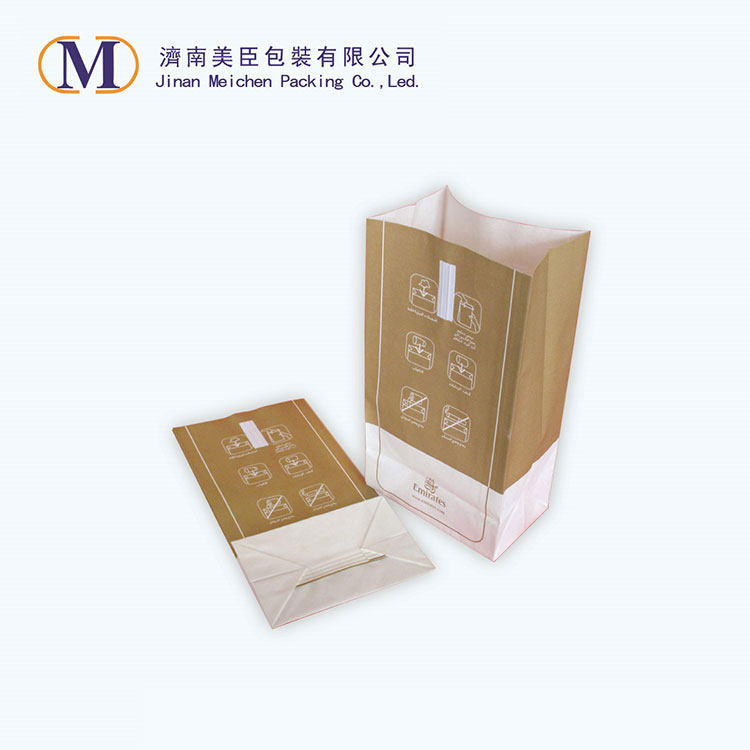Materials Used in Custom Airsickness Bags: How They Differ from Standard Bags
2024-07-02
Airsickness bags are essential items in air travel, providing comfort and assurance to passengers prone to motion sickness. While standard airsickness bags serve their purpose, custom airsickness bags offer enhanced features and materials tailored to specific needs and branding requirements. This blog explores the materials typically used in the production of custom airsickness bags and how they differ from standard options.
Standard Airsickness Bags: The Basics
Standard airsickness bags are designed to be functional, cost-effective, and disposable. They generally consist of the following materials:
1. Paper: Most standard airsickness bags are made from a wax-coated or plastic-lined paper, providing a basic level of liquid resistance. The paper is lightweight, inexpensive, and easy to print on, making it suitable for bulk production.
2. Plastic Lining: A thin plastic lining (usually polyethylene) is often added to the interior of the paper bag to enhance its leak-proof properties. This lining ensures that the bag can contain liquid without leaking, although it may not be entirely reliable for larger volumes or extended periods.
Custom Airsickness Bags: Enhanced Features and Materials
Custom airsickness bags take the basic design of standard bags and improve upon it with enhanced materials and features. These enhancements are often driven by specific airline requirements, branding, and passenger comfort considerations. Here are the key materials used in custom airsickness bags:
1. High-Quality Paper: Custom bags often use higher-grade paper that is thicker and more durable. This premium paper can handle more stress and reduce the likelihood of tearing, providing a more secure option for passengers.
2. Advanced Coatings: Instead of basic wax or polyethylene coatings, custom bags may use advanced coatings that offer superior liquid resistance and durability. These coatings can be more effective at preventing leaks and maintaining the integrity of the bag.
3. Multi-Layer Laminates: Some custom airsickness bags use multi-layer laminates that combine different materials to achieve optimal performance. These laminates can include layers of paper, plastic, and even foil to provide a robust, leak-proof barrier.
4. Custom Linings: Enhanced plastic linings or biodegradable liners can be used in custom bags to improve leak resistance and environmental sustainability. These linings are designed to handle higher volumes of liquid and provide a more reliable seal.
5. Reinforced Seams: Custom airsickness bags often feature reinforced seams to prevent splitting under pressure. These seams are carefully designed and tested to ensure they can withstand the stress of use without compromising the bag's integrity.
6. Custom Printing and Branding: Custom bags allow for high-quality printing and branding, using eco-friendly inks and processes. Airlines can print logos, safety instructions, and even advertisements on these bags, turning a simple utility item into a branding opportunity.
Differences and Benefits of Custom Airsickness Bags
The materials and features of custom airsickness bags offer several advantages over standard options:
1. Improved Durability: The use of higher-quality materials and reinforced seams ensures that custom bags are more durable and less likely to fail during use.
2. Enhanced Leak Resistance: Advanced coatings and multi-layer laminates provide superior leak resistance, giving passengers greater confidence and comfort.
3. Branding Opportunities: Custom printing allows airlines to reinforce their brand image and provide useful information to passengers, enhancing the overall travel experience.
4. Environmental Considerations: Custom bags can incorporate eco-friendly materials and coatings, reducing the environmental impact compared to standard plastic-lined paper bags.
5. Passenger Comfort: The improved materials and design features of custom airsickness bags contribute to a better overall passenger experience, addressing both practical needs and psychological comfort.
Conclusion
In conclusion, custom airsickness bags represent a significant upgrade from standard options, utilizing superior materials and advanced design features to enhance durability, leak resistance, and branding opportunities. By investing in custom airsickness bags, airlines can provide a higher level of comfort and assurance to their passengers, while also promoting their brand and addressing environmental concerns. As air travel continues to evolve, the materials and designs of custom airsickness bags will likely continue to improve, further elevating the passenger experience.



